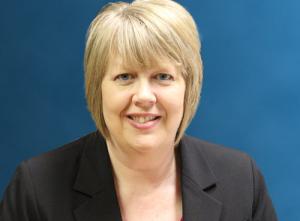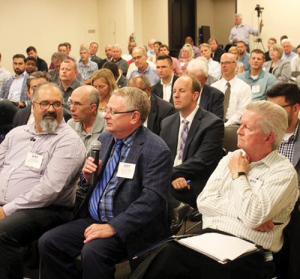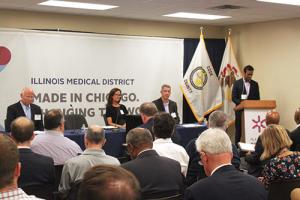Smarter States, Smarter Communities
Lori Sorenson is the Chief Networking Officer for the State of Illinois' Department of Innovation & Technology.
PUF: What is your role here?

Lori Sorenson: I am responsible for our network operations at the state of Illinois. Our agency is the Department of Innovation & Technology. That is a new agency that pulls all the IT operations from the different state agencies into one single agency with cabinet-level leadership. My responsibility is to provide the network services to not only the state agencies, but we also run a fiber broadband network that serves our K-12, local governments, and higher education.
PUF: What's new in this area, whether it's lighting, mobility or otherwise integrating new technologies, data and analytics into services?
Lori Sorenson: Illinois is one of the first states to put together an enterprise strategy for how to build a smart state. We started about three years ago through listening sessions with local governments, private sector, and industry groups to understand what the need is among the local governments, and what the new opportunities and possibilities are with the new technologies and capabilities.
We looked at what's happening around the world, took all that information and brought that together to develop a strategy on how we could as a state tackle the expansion, growth, development of smart cities, and smart state technology.
 Lori Sorenson: In Illinois our two primary providers are ComEd and Ameren. They participated in the workshop with us, talked about their rebate programs, how they worked with the communities depending on who is the provider, and who owns the pole.
Lori Sorenson: In Illinois our two primary providers are ComEd and Ameren. They participated in the workshop with us, talked about their rebate programs, how they worked with the communities depending on who is the provider, and who owns the pole.
After that we put a strategy together, and put a white paper out, and that's public. We've now moved on to ideas and concepts and broken that down into workable strategies. One of those strategies, the one that I worked on directly, has to do with our smart lighting.
Of all the feedback we've heard, smart lighting was one of those key areas, key technologies that will become a foundation for implementing smart city technology. That is because so many governments are challenged now with budgets. You come in and you bring a new idea, or a new capability, and if it costs a lot of money, where is that money going to come from in the budget?
Smart lighting is one of those where you start to see instant payback. By implementing smart lighting, you can reduce your energy costs by over fifty percent or more. If you even are in the marketplace, the vendors and the communities come to the point where they will finance that project with those energy savings, and partner together with the community. So, you're not having to come up with that capital cost.
That was an area we looked to. We talked with local governments. In Illinois, we have the city of Chicago, and other larger communities, but then we're mainly made up of mid-size and smaller communities. Those governments said, we're stuck, we don't know how to start, where to start, what makes up a good smart lighting solution. How do we go out into the marketplace to put together our specifications? What are those requirements, so we end up with a good solution that's reliable, scalable, and sustainable?
 Lori Sorenson: Illinois is one of the first states to put together an enterprise strategy for how to build a smart state.
Lori Sorenson: Illinois is one of the first states to put together an enterprise strategy for how to build a smart state.
That's where we leveraged expertise that we had within the state. We tapped into our universities and brought together some experts. We developed a request for proposal, and put that out on the street, with the goal of establishing a master contract that could be leveraged by local governments who are looking to implement smart lighting.
We were successful and awarded a contract to three different vendors last year. We began having informational sessions with the local governments and started to connect those vendors with the local governments, to start looking and exploring implementation.
When we held an information session last fall, we had tremendous interest from local governments. We even had to cut off registration when it started to exceed the capacity of our facility. It was a great day.
We had communities there of all sizes and different stages of the smart lighting journey. Some had already put in LED but had not yet installed adaptive controls and were ready to go to that next level. We had some that were getting ready to start.
It was a great conversation to help folks understand how the journey progresses, and how you go about building that value statement and working with your local boards and villages to get those kinds of projects approved.
It was also seeing what are some good fundamentals that you need to follow as you're adapting. What is that value coming from? On LED, what kind of savings do you get when you add the adaptive controls? Then what is the value if you start adding the value-add services, like sensors, cameras, noise detection, those kinds of capabilities, and then build from there.
PUF: Is this all over the state?
Lori Sorenson: We did have full representation of the state, interest from all over, and from various sizes. So that master contract helped the local governments. They do not have to do all that research and put together specifications and go through a lengthy procurement process to enter into a contract with a vendor.
Now they have three vendors. The state has already done that whole procurement process. We have vetted those vendors. They have quality products and solutions, experienced vendors with contract terms and conditions, and now a community can start working with them, and start building to the specific needs of their community, build a plan, a program, a budget, and begin to implement it.
Last fall when we held that session, we had some communities that were ready to roll. They'd already put the lighting in, and they were ready for adaptive controls, which was great. They started reaching out to those vendors and started to get specific about how they could implement adaptive controls.
We heard from some other communities that are ready to start from the beginning. They're starting from scratch, and they're working with those vendors to develop a plan and budget to go LED, adaptive controls, and do a full implementation.
PUF: Were the utilities participating and can they be helpful?
Lori Sorenson: Yes, they can be helpful. In Illinois our two primary providers are ComEd and Ameren. They participated in the workshop with us, talked about their rebate programs, how they worked with the communities depending on who is the provider, and who owns the pole.
That was fabulous. The utilities were great right from the start, have reached out to us, and want to be a part of the solution.
PUF: What's next?
Lori Sorenson: This is a continuum. This is our new norm, as the technologies are going to keep evolving. We've broken our statewide strategy, and our effort, into different areas.
We are working with our Department of Transportation and our Department of Economic Opportunity. They are looking at smart technologies in transportation for safety and efficiency and are looking at how we can leverage state assets.
We have over a thousand miles of state-owned fiber, and most of that runs along our interstate rights-of-way. What can we do with that, to partner with the private sector, to help with the evolution of autonomous vehicles, traffic management, and other technologies? We've got some working groups that are pursuing those efforts, gathering information and looking for the best opportunity and how to move that forward.
We have a group that's working on buildings. One of the first things it did was try to measure what is the utility usage at state-owned facilities? What's the baseline, and what are our energy costs and usage?
Then we're working with the stage agency that manages buildings and facilities, and the agency that does construction of new facilities and buildings. How do we start integrating energy efficiency and smart technologies in those buildings? Integrating over time as we want to watch and see what that does, and what's our energy consumption, if we integrate some technologies in the legacy buildings.
PUF: How long before the state of Illinois reaches the Jetsons level?
Lori Sorenson: We want that engagement with citizens to be real time, meaningful, and specific. We want to use the technology to drive efficiencies and cost savings in operations. We want to use it to spur and spark economic development, and we want to use it to help address digital equity and digital inclusion in the state.
The last two sometimes get left off technology. For digital equity and inclusion, in order to drive the smart cities, smart technologies, you must have broadband services. So, you're making investments in infrastructure to get the connectivity, and you're building wireless networks.
By doing that, it helps to expand and improve access to broadband services within communities, to the citizens. It helps to lower the costs. It's good to have those kinds of engagements that are helping to build digital skills.
In economic development, if we are a state where we're rolling out smart lighting, and smart building technologies, and are putting in the infrastructure and the capability for smart vehicles and autonomous vehicles, we want to attract companies to come to our state that are building those technologies. We want to be a place where we can test out those technologies, and where they can be deployed and grown. We want to get feedback and build that new business space.
'Smarter States, Smarter Communities' interviews:
- Sue Gander and Dan Lauf, National Governors Association
- Sara Bluhm, New Jersey Board of Public Utilities
- Robby Demeria, Commonwealth of Virginia
- Duane Schell, North Dakota Information Technology Department
- Lori Sorenson, State of Illinois Department of Innovation and Technology
- Jonathan Schrag, Rhode Island Division of Public Utilities and Carriers



